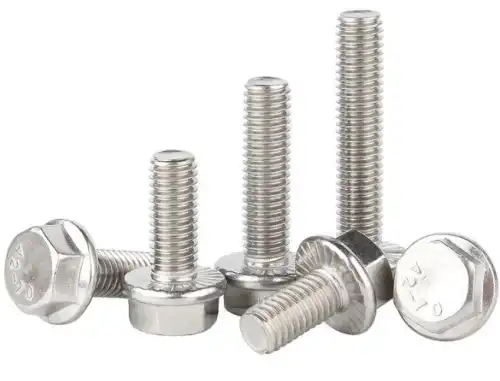Hexagonal flange bolts are bolts consisting of a hexagonal head and flange, screw two parts of a one-piece bolt, with the nut used to fasten the connection of two through-hole parts.
Are there any characteristics of hexagonal flange bolts?
Ordinary bolts have a thick nail head, are difficult to deform, and are easy to loosen after tightening.
Compared with ordinary bolts, hexagonal flange bolts have a larger ratio of support area to stress area, a higher preload force, and better relaxation performance, and are characterized by precise decoration and strong endurance. Hexagonal flange bolts-head smaller with holes, and with groove bolts, in the event of a slight deformation, can be locked more strongly; flange according to industry needs, divided into flat bottom and tooth shape, the latter is more able to play a role in fastening.

Why is the hexagon, and not the other?
Many people will have such a question, why the bolt is designed into a hexagonal shape? And not others? Hexagon is the product of mutual compromise between side length and screwing angle.
Bolts with an odd number of side lengths will have the phenomenon that the two sides of the wrench are not parallel, coupled with the fact that in the very early days, there were only fork-shaped wrenches, and most of the wrench heads were flared, so that unscrewing the wrench was not suitable for the force. In addition, the screwing angle is also an important factor to consider. If it is four angles, the wrench needs to be twisted 90 degrees to fix the screws, which is not conducive to the installation of narrow space; if it is octagonal or ten angles, the screwing angle, although it becomes smaller, but the force becomes smaller and easier to round.
Therefore, a hexagonal shape is a more common choice for bolts.
Field of application
According to different places of use, hexagonal flange bolts have different requirements. Generally speaking, hexagonal flange bolts are widely used in industrial and civil construction, cranes, excavators, and other heavy machinery.
It is said that every man has a dream of driving an excavator at the bottom of his heart, so let's unlock the applications and mysteries of excavators.
Thin rod flange bolts are favorable for connections subject to variable forces. Excavator bolt connection force way, there are ordinary and reamed holes with distinction. Flange bolts with reamed holes need to be matched with the size of the holes when subjected to lateral force, to meet the needs of the excavator after installation locking, the rod has holes, and these holes can make the bolts not easy to loosen when subjected to vibration. When installing the mating bolts in the excavator, the bolt head should be placed on the upper side of the connection, and the order from the center to the edge of the bolt connection (in all four directions) should be used to apply simultaneous counterpressure on the nut and the bolt head to complete the tightening of the bolts.
Anti-corrosion protection and sealing of bolted connections
To prevent plastic deformation under external tension, a primer (e.g. epoxy resin, zinc powder, etc.) can be applied to the contact surface of the bolted connection, or the bolts come with their coating.
With the changing market demand, hexagonal flange bolts have derived various new varieties. Cross recessed concave hexagon head bolts, hexagonal flange wood bolts, hexagonal flange triangular tooth self-locking bolts, hexagonal flange face self-tapping and self-drilling bolts, hexagonal flange face self-tapping and self-drilling bolts (coated + EPDM composite pads) and so on.











